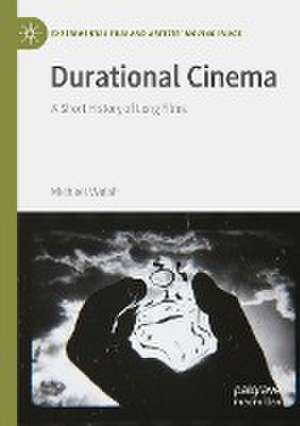Durational Cinema: A Short History of Long Films: Experimental Film and Artists’ Moving Image
Autor Michael Walshen Limba Engleză Paperback – 9 dec 2023
| Toate formatele și edițiile | Preț | Express |
|---|---|---|
| Paperback (1) | 724.80 lei 6-8 săpt. | |
| Springer International Publishing – 9 dec 2023 | 724.80 lei 6-8 săpt. | |
| Hardback (1) | 730.02 lei 6-8 săpt. | |
| Springer International Publishing – 9 dec 2022 | 730.02 lei 6-8 săpt. |
Preț: 724.80 lei
Preț vechi: 883.91 lei
-18% Nou
Puncte Express: 1087
Preț estimativ în valută:
138.71€ • 150.62$ • 116.51£
138.71€ • 150.62$ • 116.51£
Carte tipărită la comandă
Livrare economică 23 aprilie-07 mai
Preluare comenzi: 021 569.72.76
Specificații
ISBN-13: 9783030760946
ISBN-10: 3030760944
Pagini: 289
Ilustrații: XIII, 289 p.
Dimensiuni: 148 x 210 mm
Greutate: 0.36 kg
Ediția:1st ed. 2022
Editura: Springer International Publishing
Colecția Palgrave Macmillan
Seria Experimental Film and Artists’ Moving Image
Locul publicării:Cham, Switzerland
ISBN-10: 3030760944
Pagini: 289
Ilustrații: XIII, 289 p.
Dimensiuni: 148 x 210 mm
Greutate: 0.36 kg
Ediția:1st ed. 2022
Editura: Springer International Publishing
Colecția Palgrave Macmillan
Seria Experimental Film and Artists’ Moving Image
Locul publicării:Cham, Switzerland
Cuprins
1. Introduction.- 2. The New York Avant-Garde of the 1960s.- 3. European Art Cinema in the Years After 1968.- 4. Gallery and Museum Spaces Since the 1990s.- 5. Durational Documentary.
Notă biografică
Michael Walsh was born in London of Irish immigrant parents and educated at Sussex, UK, and Buffalo, USA. He has chaired Cinema Departments at Binghamton University, USA, and University of Hartford, USA, where he is currently Associate Professor. He has published widely on film, literature, and theory.
Textul de pe ultima copertă
This book argues for a durational cinema that is distinct from slow cinema, and outlines the history of its three main waves: the New York avant-garde of the 1960s, the European art cinema in the years after 1968, and the international cinema of gallery spaces as well as film festivals since the 1990s. Figures studied include Andy Warhol, Ken Jacobs, Chantal Akerman, Marguerite Duras, Claude Lanzmann, James Benning, Kevin Jerome Everson, Lav Diaz, and Wang Bing.Durational cinema is predominantly minimal, but has from the beginning also included a more encompassing or encyclopedic kind of filmmaking. Durational cinema is characteristically representational, and converges on certain topics (the Holocaust, deindustrialization, the experience of the working class and other marginalized people), but has no one meaning, signifying differently at different moments and in different hands. Warhol’s durational cinema of subtraction is quite different from Jacobs’s durational cinema of social disgust, while Lav Diaz’ durational sublime is quite different from Kevin Jerome Everson’s unblinking studies of African-American working people.
Caracteristici
First history of durational cinema as such, distinguishing it from slow cinema Cuts across the critical categories, from avant-garde film to video installation to documentary Proposes that durational cinema is predominantly minimal, but also included a more encyclopaedic kind of filmmaking





